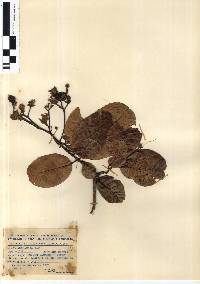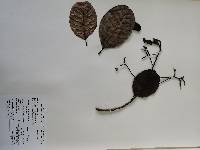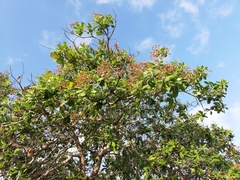
Neotropical Flora
|
Family: Anacardiaceae
[Anacardium amilcarianum Machado] |
Small cultivated tree, usually to 8 m tall and 25-30 cm dbh; branches roughened somewhat with prominent lenticels. Leaves simple, alternate; petioles 1-1.5 cm long; blades obovate, rounded to emarginate at apex, mostly acute at base, 6-16 cm long, 4.5-8 cm wide, glabrous; midrib and major lateral veins impressed and paler above, raised and paler below, the reticulate veins obscure. Panicles terminal; flowers bisexual, pedicellate, 5-parted, fragrant, puberulent on exposed parts outside; calyx lobes sharp; petals reflexed at about middle, sharply lobed, 1-2 mm wide, white to reddish near middle at anthesis, otherwise greenish; stamens 10, 1 much longer, exserted, the shorter ones held about midway in tube formed by recurved petals, often of different lengths, sometimes sterile; anthers occasionally with one theca held higher than the other; filaments fused near base; style 1, minute; nectar collecting both within ring of petals and between petals and sepals. Nuts reniform, 2-3.5 cm long, violet-purple to brown, borne at apex of an obovate, bright red, edible, fleshy hypocarp (the accrescent pedicel); mesocarp thin; seed l. Croat 6917. Cultivated at the Laboratory Clearing. Flowers from November to May (sometimes from October). The fruits mature from April to July (sometimes from December). Native to the American tropics, but cultivated throughout the tropics. In Panama, known principally from tropical moist forest in the Canal Zone (both slopes), Chiriqui, Veraguas, Los Santos, Herrera, Panama, and Darién; known also from tropical dry forest in Panama (Taboga Island), from premontane wet forest in Colón, Chiriqui, and Panama, and from premontane moist forest in Panama. Anacardium occidentale L. Marañon. Arbol, arbolito, naturalizado, cultivado y adventicio, ocurre de 0 a 900 m; en suelos pobres, arcillosos o arenosos; se puede observar en cercas vivas, en solares o expontaneamente en areas perturbadas. Esta especie es muy conocida tanto en Colombia, como Centro y Sur America, todos saben que es alimenticio y medicinal. Por lo que hablaremos de otros usos poco conocidos: Es una especie indicadora de suelos pobres, con un alto potencial como cobertura productora, ya que se da muy bien en suelos degrados por mineria de aluvion; excelente alimento para la fauna, ornamental. Caucasia Ant, 50 m. |
|
|
|
Powered by Symbiota.






















































































